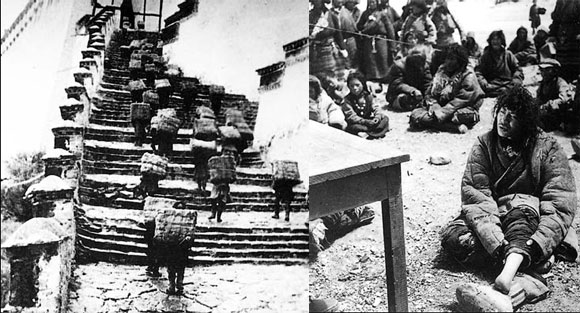Documents present picture of brutal past
(China Daily)
Updated: 2008-04-10 07:24
Updated: 2008-04-10 07:24
|
Left: Serfs carry goods to the Potala Palace. Right: A herdsman's left foot was chopped by the head of his tribe. File photo |
Among the documents at the Archives of the Nationalities Cultural Palace in Beijing are some that hint that a feudal-serfdom institution existed in Tibet before the democratic reform in 1959, which was more brutal than the system of medieval Europe.
According to the Thirteen and Sixteen laws - the Tibetan feudal legal codes that were compiled in the 17th and 18th centuries and were applied until 1959 - Tibetans were divided into three social strata within nine grades:
In the upper stratum, the King of Tsang and other rulers belonged to the upper grade; Geshes, teachers of morals, abbots, high-ranking officials, or "headmen who had more than 300 attendants and servants", the middle grade; while "the independent bachelors, servants doing odd-jobs in government offices" were relegated to the upper grade of the lower stratum; "blacksmiths, butchers and beggars who had permanent residence and paid taxes", to the middle grade of the lower stratum; and "women, beggars, butchers and blacksmiths" to the lower grade of the lower stratum "whose life-price was a straw rope".
Documents kept at the Archive of the Tibet Autonomous Region show the monasteries, officials and aristocrats owned, governed and inherited all the arable land and pastures.
The social strata were strictly followed.
One sentence in Article Three of the Thirteen Laws, a copy of which is filed under the No MB101 in the Archives of the Nationalities Cultural Palace, reads: "Persons of low social stratus who quarrel with those of high status shall be arrested".

The eighth article of the Thirteen Laws says: "A drop of blood of the people of high status is worth one qian (0.16 oz) of silver, while a drop of blood of the people of low status is worth one li (one 10th of a qian) of silver".
Figures from the old Tibetan local government from June 1959, which are kept at the Tibet autonomous region's archives, show that of the 3.3 million khals (in Tibetan measurements, about 541,200 acres) of land under cultivation in old Tibet, local government officials owned 1.2 million, or about 39 percent; aristocrats owned 790,000, or 24 percent; and the high clergy owned 1.2 million, or 37 percent. These "manorial lords", accounted for just 5 percent of the population.
The serfs and house-slaves who accounted for 95 percent of the population were the property of serf owners.
Even their offspring became the property of the serf owners from birth.
According to many original contracts preserved in the Archives of the Nationalities Cultural Palace and the Archive of the Tibet Autonomous Region, the manorial lords had the freedom to exchange serfs or present serfs to each other as gifts.
Serfs had to pay high interest on their debts by doing corvee (unpaid labor) or by selling their own children.
A certificate, written in the old form of the Tibetan language, used before 1959 and kept as No MC 1015 File at the Archives of the Nationalities Cultural Palace, reads: "Being unable to pay back the money and grain we owe Nedong Dekhang, we, Tsewang Rabten and my wife, serfs of the Dusong Manor, must give up our daughter Gensong Tonten and younger son Padma Tenzin to Dekhang to repay the debts. The descendents of their son and daughter will be Dekhang's serfs."
Part of another contract, also kept at the Archives of the Nationalities Cultural Palace, as No MC 10144 File, was signed in 1947 by Drashi Choda to pay off his debt by letting his sister Tsering Lhamo work for Lharang without pay for 10 years.
It reads: "I, Drashi Choda, belong to the Nari Monastery of the Nari Manor. I borrowed 34 khal (about 1,047 pounds) and 3 sheng (0.085 bushels) of grain from the Lharang granary in the Wood-Monkey year, the interests of which amount to 6 khal (184 pounds) and 14.5 sheng (0.41 bushels). The principal and the interest total 40 khal (1,232 pounds) and 19.3 sheng (0.49 bushels) of grain.
"As I am unable to pay back the sum annually, I ask my younger sister Tsering Lhamo, who shares weal and woe with me, to pay off my debts by doing 10 years' unpaid service for the Lharang beginning at the first day of the 12 month of this Fire-Dog year."
The contract also stipulates: "In case of violation of the contract, Drashi Choda shall be punished according to the local law."
According to old Tibetan administration records of 1950, kept at the Archive of the Tibet autonomous region, 90 percent of Tibet's 1 million people were homeless. Of the 20,000 in Lhasa at the time, more than 1,000 families lived as beggars.
Some serf owners tortured their slaves by chopping off their feet and hands, gouging out their eyeballs, cutting off their tongues or pushing them off cliffs.
They could do this legally, because they were protected by the Thirteen and Sixteen Laws.
Article Four of the Thirteen Laws stipulated: "Those who loot, kidnap, steal and kill, commit armed robberies or rebel against the authorities shall be punished corporally by: gouging out the eyes; cutting off the foot, tongue or hand; being pushed off a cliff; drowning; or execution."
China Daily

(China Daily 04/10/2008 page5)
|
||
|
||
|
|
|
|
